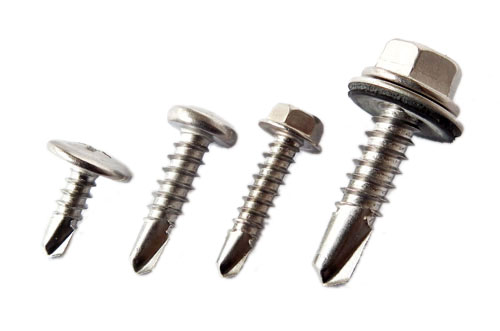What do you do with the metal chips that are bound to get stuck in the works, and potentially work their way into the electronic hardware?
I think those may be meant for other tasks, and not in control panels.
What do you do with the 'metal chips' when you drill and tap?
I do the same..
Edit: Smart-arse mode disengaged:
These are used for mounting ducting and din rail. It is easy to vacuum, blow-off or sweep up any swarf at this stage.
For mounting things like heavy drives, transformers, etc. our standard is to drill and tap.
This type of self drilling screw is used very commonly in Australia for control panels. It seems you yanks love to drill and tap everything. Don't get me started on slotted head screws and imperial thread sizes.
The reason yanks drill and tap everything is for earth bonding. In oz as you know we have a earth bar, but have a look at a yank panel and there is none.
Pearson packaging (USA) build there machines like this, and this is how they end up installed in oz.
I use button techs, but old school panel builders in oz will drill and tap. This is usually specified or used to by public works departments.
The reason yanks drill and tap everything is for earth bonding. In oz as you know we have a earth bar, but have a look at a yank panel and there is none.
Pearson packaging (USA) build there machines like this, and this is how they end up installed in oz.
I use button techs, but old school panel builders in oz will drill and tap. This is usually specified or used to by public works departments.
I'm pretty sure that we are not allowed to use mounting screws as grounding paths. I have a ground bar located in the corner of each of my panels. And use either galvanized back panels or remove the paint beneath the mounting location of the grounding bar and underneath one of the mounting locations of the back panel to the panel.
The reason I drill and tap all of my back panel mountings is because if I ever have to remove something, drilled and tapped fasteners remove a heck of a lot easier than a self tapper which stops about 1/8 to 1/4" (3-6 mm) from actually being removed and I then have to grab it with a pair of pliers and wiggle it out of the hole. I did meet one person who used self-tappers, but after he mounted everything, he went back behind the back panel and cut off all the drill tips of the self tappers... not sure how well that worked out of him.
I always felt that self-tappers on a back panel were a (not to offend) "lazy" route. Like when I go to remove a bracket from a machine and find that the maintenance crew welded it in place... they didn't want to take the time to do it "right" and drill and tap instead.
Measure/Mark all the holes, drill, a quick, light chamfer to remove any burrs, tap the holes. Usually use 10-32 screws. I prefer them over the coarse thread, a bit more bite. Pan Head, Phillips. Don't think I own any slot screws.
Though I have yet to put an earth bar in any of my personal boxes, us yanks do use them. Control panels built at Diamond Power in Ohio (used to work there) use them, for one.
I make pretty small boxes and I've gotten fond of using the 3-level ground push-in terminal blocks from Phoenix Contact. I'll bunch them up and use that as the star point.



Any metric fastener should do it.
Did you draw a panel layout with mounting hole locations in cad?
If so print it out real size ($1 at your local print studio) and duct tape it to your panel. Drill and tap.
